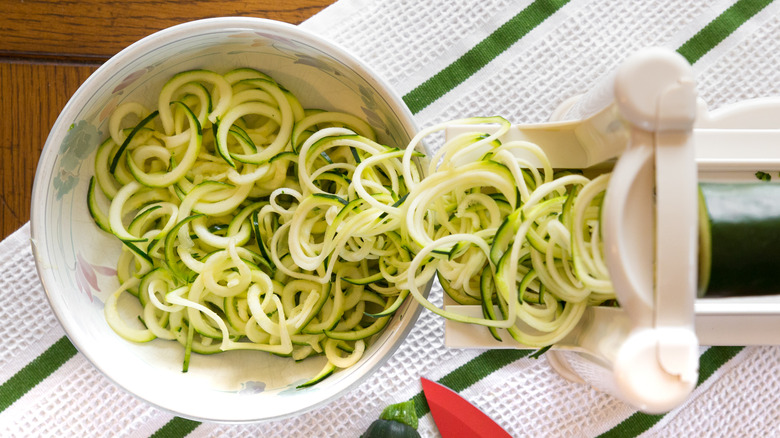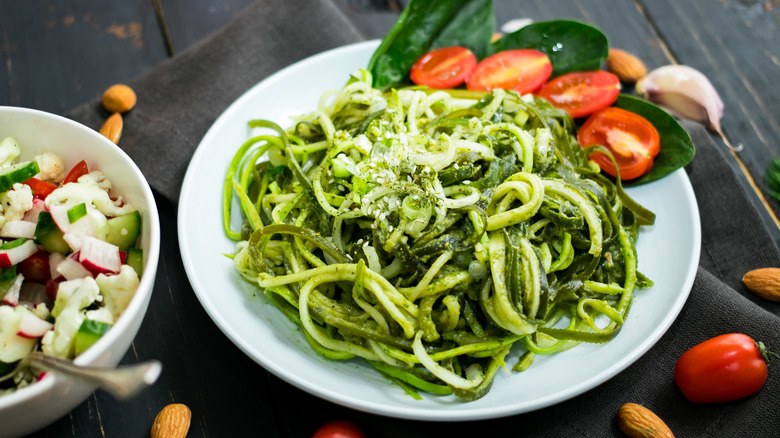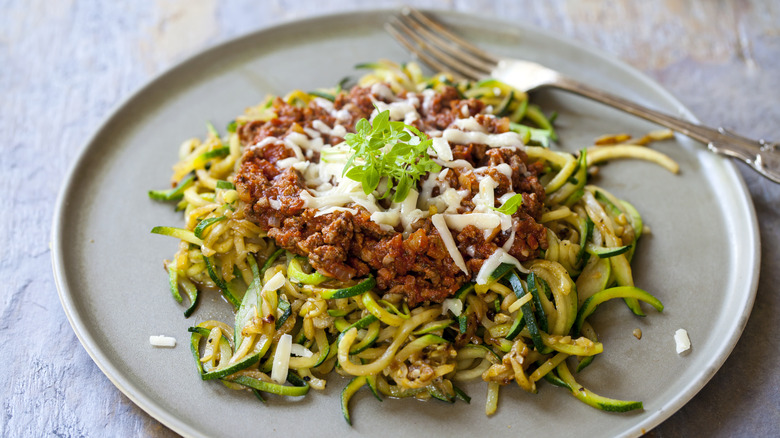The Reason Your Zucchini Noodles Turned Out Soggy
Zucchini noodles (often called zoodles) can be a tasty pasta substitute for veggie lovers, but since this squash is made of 94% water, it should come as little surprise that your noodles can wind up pretty soggy. Simply slice up the squash and cook it without draining this excess moisture, and you're on the path to disaster. A few extra measures can make the difference between light, delicious zoodles and a watery mess that falls apart before you can take a bite.
One contributing factor is the zucchini's size. Larger zucchinis hold more water and seeds, both of which can disrupt the structural integrity of your noodles. You're better off looking for smaller zucchinis at the store. An even bigger error is neglecting to remove excess water before cooking the noodles. After slicing the veggie into ribbons, be sure to squeeze your zucchini noodles with paper towels or a dish towel to get them as dry as possible. You can also sprinkle them with salt and let them sit to draw out more moisture.
Like any other type of noodle, zucchini noodles can also become soggy if they're overcooked. Unlike wheat noodles, though, raw zucchini noodles are perfectly edible, so you're better off slightly undercooking them rather than overcooking. On a similar note, you should avoid cooking zoodles directly in a soup or sauce, as they'll soak up the liquid and become mushy. Instead, try sautéing or roasting your noodles before tossing them with sauce or other ingredients.
Additional tips for perfect zucchini noodles
While squeezing or salting your zoodles will prevent sogginess, the best choice is to perform both steps. It might take a little longer, but the final results will be worth it. Spread out your noodles out on a cutting board or baking tray, sprinkle generously with salt, and let them sit for at least 10 to 15 minutes. The salt will draw out the veggie's moisture via osmosis, and you'll likely see a layer of water emerging on the noodles' surface.
To finish the prep work, wring out the extracted water by squeezing the noodles with a towel. If you're making a lot of zoodles, salt and drain them in batches. If you try to prep them when they're in a pile, all that overlap will reduce the salt's effectiveness. Additionally, while you might think to save time by drying your noodles in a salad spinner, we recommend against that. Not only can a salad spinner damage your delicate noodles, but it only removes water on the surface, not within the zucchini as well.
If you're still worried about your zoodles falling apart, try cutting wider noodles. Wider ribbons of zucchini better maintain their structure. Delicate, angel hair-esque noodles are not only a pain to cut and keep intact while cooking, but they're also more likely to create a soggy dish.
Ways to serve raw zucchini noodles
If you choose to forgo cooking your zucchini noodles and instead want serve them raw, we've got some tasty serving suggestions. Giada De Laurentiis' favorite method to dress zoodles involves tossing them with flaky sea salt and lemon zest before adding them to a summery salad. Alternatively, you can top the noodles off with pesto and tomatoes, or even just a simple vinaigrette. They make for the easiest "pasta" salad, since you can skip the pre-cooking step.
That being said, eating raw zucchini noodles doesn't have to mean eating cold noodle dishes. Rather, you can toss the raw noodles with a heated sauce, and the final dish should be plenty warm. You can even cook up your favorite stir-fry ingredients and toss with zucchini noodles right before serving for a delicious and nutritious main or side dish. At the end of the day, zucchini noodles aren't just a health trend. They can make a flavorful substitution or addition in any of your favorite pasta recipes, so long as you make sure they don't turn to mush.



